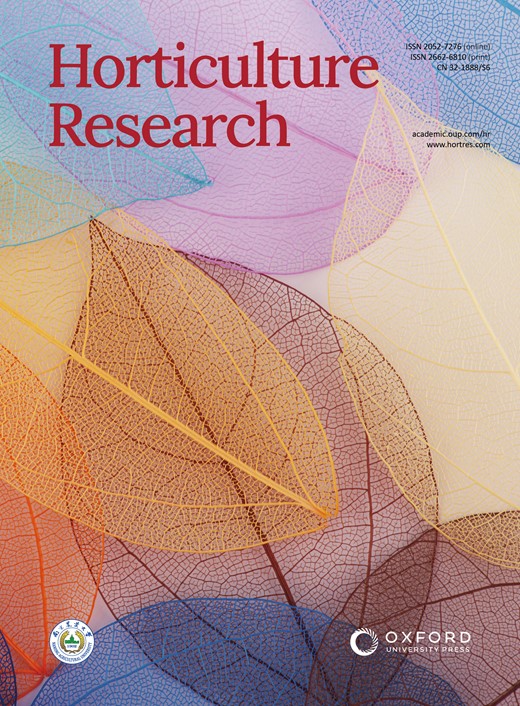辣椒的首个种间多亲本杂交(MAGIC)群体:发育、表型评价、基因组分析与展望
IF 8.7
1区 农林科学
Q1 Agricultural and Biological Sciences
引用次数: 0
摘要
本研究首次建立了辣椒八向多亲本高代杂交(MAGIC)群体。该MAGIC群体以6份辣椒和2份中国辣椒为材料,选择具有代表性和广泛的遗传多样性,并在形态、农艺和果实品质性状上具有互补性。利用可靠的描述符对其第三代自交群体进行表型分析,并利用基因分型测序(GBS)对其总体多样性、纯合性、亲本贡献和遗传结构进行基因分型评估。在表型研究中发现了很大的变异性,显示出所有方正系的多种形式的重组。此外,还发现了新的表型组合,以及数量性状的越界遗传。s3代亲本基因组分布均衡,每个s3个体似乎都包含一个独特的始祖系基因组组合,达到高纯合性。为此,对该群体的高遗传性状进行了初步的全基因组关联研究(GWAS),以评估该群体未来育种前景的潜力。被分析的大多数性状,如茎短柔毛和成熟阶段的果实颜色,都与对压力的反应和防御功能相关的相关基因有很强的关联;或果壁稠度,与脂质代谢相关基因有关。我们的研究结果表明,通过鉴定与感兴趣性状相关的基因组区域及其在更复杂的农艺和果实品质性状中未来GWAS的潜力,第一个辣椒MAGIC群体是辣椒研究和育种目的的宝贵遗传资源。本文章由计算机程序翻译,如有差异,请以英文原文为准。
First interspecific multi-parent advanced generation inter-cross (MAGIC) population in Capsicum peppers: development, phenotypic evaluation, genomic analysis, and prospects
This work presents the first eight-way multi-parental advanced generation inter-cross (MAGIC) population in pepper. This interspecific MAGIC population was built with six Capsicum annuum accessions and two C. chinense accessions, selected for encompassing a representative and wide genetic diversity, and being complementary for morphological, agronomic, and fruit quality traits. The population in its third selfing generation has been phenotyped with reliable descriptors and genotyped using genotyping-by-sequencing (GBS) to assess its overall diversity, homozygosity, parental contributions, and genetic structure. A great variability was found in the phenotyping study, showing many forms of recombination of all the founder lines. Even more, new phenotypic combinations were found, as well as transgressive inheritance in quantitative traits. The S3-generation contained a balanced distribution of the parental genomes and each S3-individual seemed to contain a unique genomic combination of the founder lines reaching a high homozygosity. In this regard, a preliminary genome-wide association study (GWAS) was performed for highly heritable traits to evaluate the potential of this population for future breeding prospects. Strong associations were found for most traits analysed, like stem pubescence and fruit colour at maturity stage, with associated genes related to response to stress and defence functions; or fruit wall consistency, with associated genes related to lipid metabolism. Our results show that this first Capsicum MAGIC population is a valuable genetic resource for research and breeding purposes in peppers, by identifying genomic regions associated to traits of interest and its potential for future GWAS in more complex agronomical and fruit quality traits.
求助全文
通过发布文献求助,成功后即可免费获取论文全文。
去求助
来源期刊

Horticulture Research
Biochemistry, Genetics and Molecular Biology-Biochemistry
CiteScore
11.20
自引率
6.90%
发文量
367
审稿时长
20 weeks
期刊介绍:
Horticulture Research, an open access journal affiliated with Nanjing Agricultural University, has achieved the prestigious ranking of number one in the Horticulture category of the Journal Citation Reports ™ from Clarivate, 2022. As a leading publication in the field, the journal is dedicated to disseminating original research articles, comprehensive reviews, insightful perspectives, thought-provoking comments, and valuable correspondence articles and letters to the editor. Its scope encompasses all vital aspects of horticultural plants and disciplines, such as biotechnology, breeding, cellular and molecular biology, evolution, genetics, inter-species interactions, physiology, and the origination and domestication of crops.
 求助内容:
求助内容: 应助结果提醒方式:
应助结果提醒方式:


